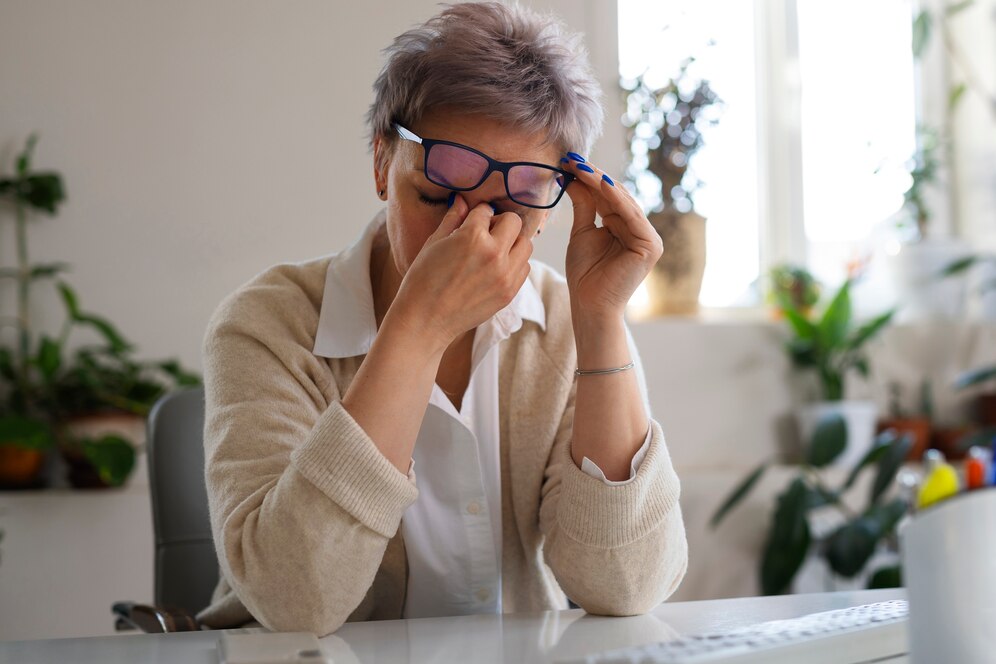
The moment our eyes get open, they start working tremendously. Processing every bit of information and performing multiple tasks throughout the day, it’s only natural that our eyes feel tired. And the endless cycle of switching between your TV, phone, and computer has created a digital permanence where a screen is always within reach, exposing the eyes to health risks due to prolonged use.
Stating facts, at least 40% of people’s waking time is spent on the screens and 75% of the world’s population needs some form of vision correction. Also, when a person focuses on digital displays, they tend to blink less. In fact, the blink rate can be reduced by a third to a half, causing eyes to dry out.
Digital displays thus cause eye strain because of all the glare and poor contrast between the screen and the background. If your eyes are getting watery, dry, itchy, sensitive to light, have a burning sensation, or causing a blurred vision, too much screen time may be to blame.
While taking a break every now and then can help, this blog gives an insight on what else you can primarily do to help prevent eye strain.
5 Tips to Relieve Eye Strain from Screen Time
Eye strain is common in today’s generation but can be treated with simple, non-invasive methods. A few tips that you can follow to get started including:
1. Take Visual Breaks
Eye strain occurs when you spend hours in front of the screen without looking away. Hence, here applies the 20-20-20 rule, which means, for every 20 minutes of your screen time, look at something at least 20 feet away for 20 seconds. This practice helps your eyes to relax. In addition, you can move about, stretch your arms, legs, shoulders, and neck to reduce tension and muscle fatigue. Maybe, a simple water refill to stay hydrated, or a short walk in the natural sunlight during lunch break is a good way to take a break from the screen.
2. Find the Right Light
Lighting can easily cause eye strain. The screen brightness should complement the surrounding light in your room. For example, light should come from behind you and not from the front. Also, too dim or too bright light can cause eyes to work harder.
If possible, use a table lamp or a floor lamp that provides softer, indirect light or maybe position the computer so windows are on your side. In addition, reduce the exterior light by closing windows, shutting the drapes, and adjusting the screen brightness as needed.
3. Invest in Quality Eyewear / Computer Glasses
If eye strain is affecting you beyond common symptoms like dry eyes and itching, consult an eye doctor to know if you need special eyewear to reduce it. Especially for those who work long hours on computer screens, certain lens coatings and tints may help. For example, photochromic lenses reduce exposure to potentially harmful blue light emitted by digital devices. Also, limiting the use of contact lenses while working on screens helps rest your eyes.
4. Adjust Computer Display Settings
Adjusting the display settings of your laptop or computer can significantly help in reducing eye strain and fatigue. Try reducing the brightness so that it complements the external surroundings and don’t get your eyes working harder. Also, adjusting the font size on the document and adjusting the contrast will enhance comfort.. For example, black font on a white page is the best combination. Another display setting that can help reduce eye strain is the color temperature. Reducing the color temperature on your screen reduces the amount of blue light emitted by your screen for better long-term viewing comfort.
5. Limit Bedtime Screen Time:
Research shows that the blue light emitted from screens may affect the body’s natural wake and sleep cycle. An individual’s natural wake and sleep cycle is most affected by the blue light emitted from your phone and other screens. Why? Blue light stimulates us and wakes us up during the day and it does the same thing at night, which makes it harder to sleep. Hence, it is advised to limit the screen time at least 2 hours before going to bed. It not only maintains the sleep cycle, reduces blue light exposure but also minimizes other health risks.
Conclusion
Having an everyday exposure to screens like computers and phones, most people around experience eye strain problems. Though eye strain is uncomfortable and irritating, it isn’t dangerous and can be prevented by following simple tips. However, if you find yourself in a tough spot related to eye discomfort, you might want to take an eye exam. Timely diagnosis and treatment help preserve vision and Prof Chameen Samarawickrama helps doing that by giving expert care and guidance.. One of the best ophthalmologists in Australia, Prof Chameen is a Consultant Eye Surgeon experienced in cataract surgery, corneal transplant, laser eye surgery, and ICL surgery.
Book your consultation today to start your treatment with the best!
